The ongoing opioid epidemic has turned the focus from other drugs to the impact of opioids on the United States. Both illicit and prescription opioids are tools in this drug crisis, which began in the late 1990s after prescriptions skyrocketed. Our Banyan Texas rehab is well aware of the effect of opioids on the nation and the importance of spreading awareness regarding their dangers. To inform the public as best as possible, we’re sharing what opioid analgesics are and the dangers they present to the mind and body.
What Are Opioid Analgesics?
Also referred to as narcotic analgesic drugs, opioid analgesics are a class of drugs that include both illegal drugs like heroin and prescription painkillers like hydrocodone. The meaning of analgesic is “acting to relieve pain,” which is why it’s applied to opioids. On the other hand, a non-opioid analgesic is basically a drug that isn’t an opioid. These types of medications - such as acetaminophen and nonsteroidal anti-inflammatory drugs (NSAIDs) - can be used for pain relief but don’t act in the same way.
Some common opioid analgesics examples include:
- Codeine
- Hydrocodone
- Hydromorphone
- Methadone
- Morphine
- Oxycodone
- Oxymorphone
- Thebaine
There are three types of opioid categories: natural, semi-synthetic, and synthetic. Natural opioids are those that are chemical compounds that naturally occur in plants like the opium poppy, including morphine, codeine, and thebaine.
Semi-synthetic opioids are opioids created in labs from natural opiates, such as hydromorphone, hydrocodone, and oxycodone. These drugs are designed to act similarly to natural opioids and produce similar side effects, including pain relief. Both natural and semi-synthetic opioid analgesics are strong drugs with a high potential for abuse and addiction.
Many people who take opioid analgesic medications for long periods unknowingly run the risk of becoming dependent. On the other hand, some purposely abuse these drugs for the euphoric and numbing high they produce. Either way, opioid analgesics are highly addictive, and most people who abuse them require opiate detox and treatment to quit and regain their health.
How Do Opioid Analgesics Work?
Opioid analgesics work by binding to opioid receptors on neurons in the central nervous system (CNS), which is the part of the opioid system that controls pain. The endogenous opioid system is one of the most innate pain-relieving systems that consists of various scattered neurons that produce three neurotransmitters: beta-endorphin, the met- and leu-enkephalins, and dynorphins.
These neurotransmitters work together with receptors called mu, delta, and kappa to produce analgesia, which is the inability to feel pain. Opioid receptors are the parts of this system that control pain as well as pleasure associated with addictive behaviors. Opioids or opiates act the same way as these neurotransmitters by attaching themselves to opioid receptors located in the brain, spinal cord, stomach, and lungs to produce pain relief and other undesirable side effects.
When these medications travel through the bloodstream and attach to receptors throughout the body, cells release signals that muffle the perception of pain and boost feelings of pleasure. Not only does this combined effect make opioid analgesics effective for treating severe, acute, and chronic pain, but it also makes them dangerous.
Side Effects of Opioid Analgesics
Aside from pain relief, opioid analgesics are also commonly abused because of the high they produce. Opioids also activate the release of neurotransmitters like dopamine and serotonin, both of which play roles in functions like pleasure, feelings of well-being, mood, breathing, and sleep.
Mild and adverse effects of opioid analgesics include:
- Euphoria
- Sedation
- Dizziness
- Nausea and vomiting
- Constipation
- Trouble breathing
- Tolerance
- Physical dependence
- Addiction
When taken in high doses, users run the risk of experiencing an opioid overdose. Overdosing on opioids produces symptoms like respiratory depression, pinpoint pupils, unconsciousness, and choking. The deadliest of these symptoms is respiratory depression, which is slow and ineffective breathing that prevents the brain and other organs in the body from getting enough oxygen to properly function. Opioid overdose brain damage can result from a lack of oxygen, as well as loss of consciousness and death.
In addition to the potential for overdose, long-term opioid abuse can also result in addiction. Abuse or misuse, in this case, refers to taking higher doses than prescribed, mixing opioids with alcohol or other substances, or ingesting pills in ways they’re not meant to, including crushing and snorting or injecting. What’s more, the longer someone takes opioid analgesics, the more tolerant their body becomes to their effects.
This requires the individual to use more of the drug to experience the same effects, which can encourage riskier and heavier drug-taking behavior. Physical dependence is also linked to increased tolerance in long-term opioid users, a condition marked by withdrawal symptoms when use is cut down or stopped. Most addicts continue abusing these drugs to avoid withdrawal symptoms and eventually find themselves unable to stop using.
How to Get Help for Opioid Addiction
Long-term opioid addiction can negatively impact a person’s physical and mental health, relationships, career, and more. If you or someone you care about is battling opioid abuse, our Texas opioid rehab can help.
We’re dedicated to helping addicts and their loved ones recover from the impact of addiction. Call Banyan Treatment Centers now at 888-280-4763 or send us your contact information to learn more about our Texas addiction treatment and how we can support long-term sobriety.
Source:
Related Reading:









